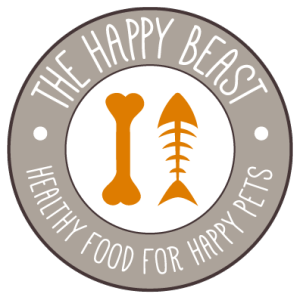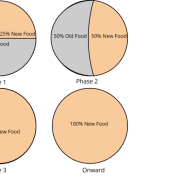How to talk to your vet about raw pet food diets
Are you considering a raw dog food diet or a raw cat food diet for your beloved companion, but feeling hesitant because your veterinarian doesn’t support raw feeding?
At The Happy Beast, we frequently hear this concern: ‘My vet is against raw food.’ This is a common challenge for pet parents advocating for fresh pet food or biologically appropriate raw food (BARF) diets.
If this sounds familiar, you’re not alone. While some veterinarians are open to fresh feeding and even recommend it, other vets express caution regarding raw food diets, primarily due to concerns about bacterial contamination and nutritional imbalances, often stemming from limited education on fresh food in vet school.
These vets still default to conventional kibble brands like Purina, Hill’s, or Royal Canin. This isn’t necessarily because your vet is uninformed or doesn’t care; it’s often because they’ve only been taught one side of the story.
In addition to dispelling concerns, we also believe it’s super important to highlight the benefits of raw pet food diets. For example, many pet parents observe significant health improvements in their animals, including glossier coats, improved digestion (leading to smaller, firmer stools), increased energy levels, and better management of allergies when switching to a species-appropriate raw diet. (Check out our blog for more info on the benefits of raw food!)
So how do you navigate this conversation respectfully, advocate for your pet’s health, and make informed choices when your vet isn’t well-versed in raw pet food or fresh diets? Let’s break it down.
Why Some Vets Don’t Support Raw Food
The simple truth is that most veterinary schools in the U.S. receive funding, teaching materials, and even entire course content from major pet food companies.
Here are some eye-opening stats:
- Purina, Hill’s, and Royal Canin (owned by Nestlé and Mars, respectively) spend millions annually sponsoring veterinary schools, providing free food to vet students, and offering continuing education credits.
- At many schools, these companies fund entire nutrition departments, sometimes staffing them with company employees.
- As of 2022, roughly 90% of veterinary nutrition courses in U.S. vet schools were taught by faculty with ties to these large pet food brands.
The result? New vets graduate with a solid understanding of formulating prescription diets and managing disease with kibble, but little to no exposure to fresh food diets, raw feeding, or holistic approaches to nutrition.
This isn’t a conspiracy theory, it’s simply the reality of corporate influence in academia. But it does mean that many vets may unintentionally equate “complete and balanced” with “kibble that comes from a bag,” and view raw food through a lens of caution or skepticism.
Beyond lack of education, some other common concerns we hear include:
- Concern: Bacterial Contamination (Salmonella, Listeria, E. coli)
- Veterinarians often raise concerns about bacterial contamination in raw pet food, specifically Salmonella, Listeria, and E. coli. This is a valid concern, and it’s why choosing a reputable commercial raw food brand is crucial.
- Most brands we recommend at The Happy Beast utilize High-Pressure Processing (HPP) or rigorous test-and-hold protocols to mitigate these risks.
- In addition, proper safe food handling practices are key; just as you would when preparing raw meat for human consumption (e.g., washing hands, separate cutting boards).
- Concern: Nutritional Imbalance/Deficiencies
- A major concern for vets is the potential for nutritional imbalance or deficiencies in raw diets. This is particularly true for homemade or ‘DIY’ raw diets that aren’t properly formulated.
- However, commercially prepared raw pet food diets from reputable companies like Steve’s Real Food, Smallbatch, and Primal are formulated to meet or exceed Association of American Feed Control Officials (AAFCO) guidelines, ensuring they provide all essential nutrients for a pet’s life stage
- Concern: Bone Hazards (choking, obstruction, dental damage)
- Some veterinarians also express apprehension about bones in raw diets, citing risks of choking hazards, gastrointestinal obstruction, or dental damage.
- In reality, commercially prepared raw diets typically use finely ground bone or appropriate bone content that is safe for consumption.
- Reassure your vet that you’re not feeding large, weight-bearing bones that could cause issues, but rather appropriately sized and prepared raw pet food that simply uses bone as one component.
Tips for Talking to Your Vet About Raw Food
You and your vet should be on the same team when it comes to your pet’s well-being. Here are a few ways to approach the conversation with openness and confidence:
1. Be Respectful, But Curious
Instead of challenging your vet’s opinion right off the bat, try asking questions that invite dialogue. For example:
- “What concerns do you have about raw food?”
- “Are there particular brands you’ve seen issues with?”
- “Are you familiar with companies that use HPP or test-and-hold protocols?”
This helps shift the tone from confrontation to collaboration.
2. Do Your Homework
Come prepared with information about the brands you’re feeding, or considering feeding. Highlight their safety practices, sourcing standards, and track record. Many raw food companies publish third-party test results and sourcing information directly on their websites.
It also helps to share your personal experience. If your dog’s allergies cleared up, or your senior cat has more energy than ever on a raw diet, that’s valuable data, even if it’s anecdotal.
3. Differentiate Between Raw Feeding and DIY Raw
A lot of vets worry about homemade raw diets because, frankly, many of them are unbalanced. Make it clear that you’re feeding a commercially prepared raw diet from a company that follows AAFCO guidelines, uses safe handling practices, and provides complete and balanced nutrition.
Brands like Steve’s Real Food, Smallbatch, and Primal all have rigorous safety standards and transparent sourcing. These aren’t “backyard butcher” meals; they’re carefully crafted foods designed to nourish your pet.
4. Be the Bridge
You might be the first person to bring up fresh feeding in your vet’s practice. That can feel intimidating, but it’s also an opportunity. You don’t need to convince your vet to become a raw food evangelist, just to be open to your choice and support you in monitoring your pet’s health.
Offer to share your resources, or even ask if they’d like to talk to someone at your favorite raw food company. Many of them employ vet nutritionists or holistic DVMs who can provide evidence-based education.
What If My Vet Still Isn’t Supportive?
If your vet remains firmly anti-raw, you have a few options:
- Work with a holistic or integrative vet, especially one trained in traditional Chinese veterinary medicine (TCVM) or functional nutrition. Many offer virtual consultations if there isn’t one nearby.
- Find a vet who supports your choices and will monitor your pet’s health without judgment.
- Use a team-based approach, stay with your current vet for general care, but consult a holistic nutritionist for dietary guidance.
At the end of the day, you know your pet best. Vets are experts in medicine, but you are the expert on your animal’s daily life, behavior, and needs. Together, you can find the approach that works best for your individual companion.
You Deserve a Vet Who Listens
Fresh food feeding is no longer a fringe movement. It’s growing because people are seeing results. Glossier coats, fewer digestive issues, better energy, healthier teeth, and improved quality of life. When raw is done safely and responsibly, it’s not risky, it’s revolutionary!
Your vet may not have been taught this in school, but that doesn’t mean you can’t teach each other something now.
Key Takeaways for Discussing Raw Pet Food Diets with Your Vet
- Understand common vet concerns (bacteria, nutrition, bones).
- Choose reputable, commercially balanced raw food brands.
- Be respectful, informed, and ready to share your research.
- Consider holistic vets or nutritionists if needed.
Still have questions? We’ve got you covered!
Have more questions about raw feeding, finding a supportive veterinarian, or need help choosing the best raw dog food brands or raw cat food brands? Stop by The Happy Beast or contact us for personalized guidance. We’re here to help you navigate your pet’s journey to a fresh food diet safely and effectively!



